#itneg
Text
Notes on Anitismo - The Ancient Religion of the Philippines by Isabelo de los Reyes.

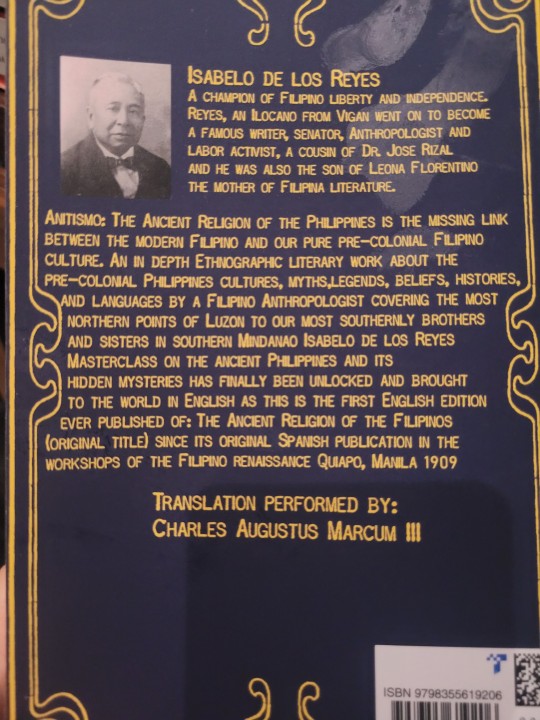
Keep in mind - this was written a while back.
Ancient Chronicles written by the Jesuit hispanic Friars state that at the that the first spaniards set foot in the Philippines from the coast of visayas to Manila there was a considerable population of Muslim converts
This was especially true for Mindanao due to conversion by Islamic teachers from Borneo
De los Reyes argues that because of this, to find native Filipino religion at its purest, we must look to the North
Distinguishing native religion without outside influence such as from Islam, Hinduism, Christianity etc can be tricky
However he argues that the traces of Native Filipino religion can be found in the stories superstitions and advice that belong to various Filipino ethnic groups (Tagalogs, Bicolanos, Zambalenos etc)
From the South of the country in Mindanao to the extreme North like Luzon, De los Reyes argues then native Filipino religion was consistent
This religion was Anitism or the Cult of Anito, meaning souls of the ancestors.
Anitism is not a monolithic religion and hosts a broad pantheon ranging from Gods to animals, nature, elements and space.
The Philippines had its own modern spiritism and De los Reyes argues this may have been the origins of the cults of "Romanist Saints" (Catholic saints) in the Philippines. By this I think he means that Filipino spirituality influenced how Filipinos proceeded with Catholic worship.
The oldest chronicles about the Philippines can be found in various museums and libraries (such as the National Library of Madrid, Covenant of St Augustine in Manila)
We can follow these chronicles, from when the Jesuit Pedro Quirino provided news of religion in the Philippines in 1604, followed by reproductions by others like the Jesuit Colin in 1663 and others such as Fr. Morga, Gonzalez de Mendoza, Aduarte etc.
Fr Morga said that Filipinos practised Anitism in certain regions like Camarines and Cagayan.
Some traditions would say that Manila and its regions were not originally native to the island - they were from Malayan islands and other remote areas.
Before the Spaniards arrived, Islamic teachers from Borneo came to preach and interacted with the locals
Their teachings and beliefs spread quickly throughout the Philippines
Fr. Grijalva writes that they (Filipinos) started adopting their traditions and took on their names.
De Los Reyes argues that Spanish conquistadors' arrival/conquest was delayed because Filipinos were already familiar with various religions and beliefs and also because of the hands of Datu Lapu Lapu. What I believe he is arguing is that Datu Lapu Lapu and the previous exposure Filipinos had to different religions at first delayed Spanish influence from spreading so quickly.
Other islanders who weren't under the control of the government in the Philippines has their beliefs influenced by religious preachers who travelled to them from the Straits of Malacca and the Red Sea.
An account, dated April 20th 1572 (preserved in the archives of India) which is from the conquest of Luzon details "In these towns, closest to the sea, they do not eat any pork, which the moors taught them. But if you ask them, they say they do not know Muhammed or his law." This account was reproduced by Wenceslao Retana.
In actuality, very few Filipinos could understand/read the teachings of the Koran despite the Islamic influence.
In Filipino traditions, reverence and worship was given to nature and the elements, and this was usually consistent throughout the islands.
Native Filipino religion beliefs include elements, animals, stars and ancestors.
Filipino religion in Manila and nearby areas was a mixture or Anitism, Buddhism, Hinduism and Islam brought by the Malays of Borneo.
Vocabulary included Sanskrit and Malay terms such as Bathala, meaning Lord.
However these terms are not used in Northern provinces.
De Los Reyes argues that Itnegs and other mountain tribes conserved and maintained the purest form of Filipino religion
In the Ilocos, Cagayan, Isabela and other provinces of Northern Luzon, native Filipino religion was more prevalent
Hindus and Buddhists converted many in Java and Malaysia.
However Muslim influence became dominant in 1478 - 60 years before the Dutch invasion.
According to Javanese legends, Hindus arrives in Java 78 years before Christ.
The first Malays came from the Minangkabau river region to establish cities in Malacca , Ojohor and Singapore in the 12th century, as per Malacca records.
In the 13th, 14th and 15th centuries, there were various Malaysian emigrations reaching the Philippines
De Los Reyes argues that Filipinos may have also populated the islands of Malaysia, and emigrations could have originated from strong winds coming down from the North.
The first Spaniards found the son of Lakandula, King of Manila, when they went to Borneo.
The emperor's master of ceremonies from Japan (Mr Fujita) argued that emigration likely came from the north and that Filipinos may have some relations to the Japanese.
According to Geographers and Historians of the Mariana Islands, what De Los Reyes calls the "know it all Spanish" - had no idea about interesting ruins found in Oceania, one of which was a prehistoric statue that was being held in the British museum.
He argues there may be hidden megaliths, artefacts, and remnants of lost civilisation in the Philippines, as seen in various locations such as : Butacan caves, Pangibalon Hill, Madias de Iloilo and Nasso.
#Philippines#pre colonial philippines#Filipino#Filipino history#Anitism#Filipino religion#Pinoy#Isabelo de los Reyes#History#Asia#Asian history#South east Asian history#Religion#ancient religion#South east asia#Colonialism#spanish colonial#Spanish colonialism#Philippines history#Philippine history#Anitismo#Keep in mind this was written a while ago so some terms may be outdated#I've tried to interpret some tricky parts the best I could#My ass who is from the Northern Philippines 🗿
51 notes
·
View notes
Photo

On this day, 20 September 1763, Filipina revolutionary anti-colonial leader of Itneg and Ilocano mestiza descent, Gabriela Silang, was executed by Spanish authorities. The previous week, she had attempted to besiege Vigan, but she was forced back to Abra, where she was later captured. She and her troops were hanged in Vigan's central Plaza. https://www.facebook.com/workingclasshistory/photos/a.296224173896073/2086853094833163/?type=3
76 notes
·
View notes
Text
AUSTRONESIAN RESOURCES
The Anthropological Masterlist is HERE.
The Austronesian people are an ethnolinguistic group that speak an Austronesian language. These include the people of Maritime Southeast Asia, Southeast Asia, and Polynesia.
BALI ─ “The Balinese people are an Austronesian people. They are native to Bali.”
─ Balinese Language
─ Balinese Traditional Architecture
BICOLANO ─ “The Bicolano people are an Austronesian people. They are native to Bicolandia in the Philippines.”
─ Bicolano Culture
─ Bikol Language
─ Bikol Dictionary
HILIGAYNON ─ “The Hiligaynon, or Ilonggo, people are an Austronesian people. They are native to the Western Visayas in the Philippines.”
─ Hiligaynon Culture
─ Hiligaynon Language
─ Hiligaynon Dictionary
JAVA ─ “The Javanese, or Javan, people are an Austronesian people. They are native to Java island in Indonesia.”
─ Javanese Information
─ Javanese History
MALAGASY ─ “The Malagasy people are an Austronesian people. They are native to Madagascar.”
─ Malagasy Culture & History
─ Malagasy Language
─ Malagasy Dialects
MALAY ─ “The Malay people are an Austronesian people. They are native to the Malay Peninsula, eastern Sumatra, and coastal Borneo.”
─ Malaysian Information
─ Malay Dictionary
MARANAO ─ “The Maranao, or Meranao, people are an Austronesian people. They are native to the island of Mindanao in the Philippines.”
─ Maranao Language
─ Maranao Grammar
─ Maranao Dictionary
MELANESIA ─ “The Melanesians are an Austronesian people that share the Melanesian culture. They are native to Melanesia.”
─ Melanesian Oral Tradition
─ European Cartography of Melanesia
─ Anglican Texts of Melanesia
NAGE ─ “The Nage people are an Austronesian people. They are native to the eastern Indonesian islands of Flores and Timor.”
─ Nage Language
PHILIPPINE ─ “The Filipino people are an Austronesian people that share the Filipino culture. They are native to the Philippines.”
─ Filipino Culture
─ Filipino History
─ Filipino Folktales
SIRAYA ─ “The Siraya people are an Austronesian people. They are native to southwest Taiwan.”
─ Indigenous Taiwanese Languages
THE SOLOMON ISLANDS ─ “The Solomon Islands are a group of Oceanian islands.”
─ The Solomon Islands Information
─ The Solomon Islands Religion
─ The Solomon Islands Language
SUNDA ─ “The Sundanese, or Sunda, people are an Austronesian people. They are native to western Java.”
─ Sundanese Literature
TINGUIAN ─ “The Tinguian, or Itneg, people are an Austronesian people. They are native to northwestern Luzon in the Philippines.”
─ Tinguian Culture
─ Tinguian Religion
#resources#austronesia#bali#bicolano#hiligaynon#java#malagasy#malay#malaysian#maranao#melanesia#nage#philippine#siraya#solomon islands#sunda#tinguian
39 notes
·
View notes
Text
I literally just read an Itneg story that could be summed up as “man uses his own hand as chopping board while bonding with his gf and has to get sent to the ER”????
0 notes
Photo
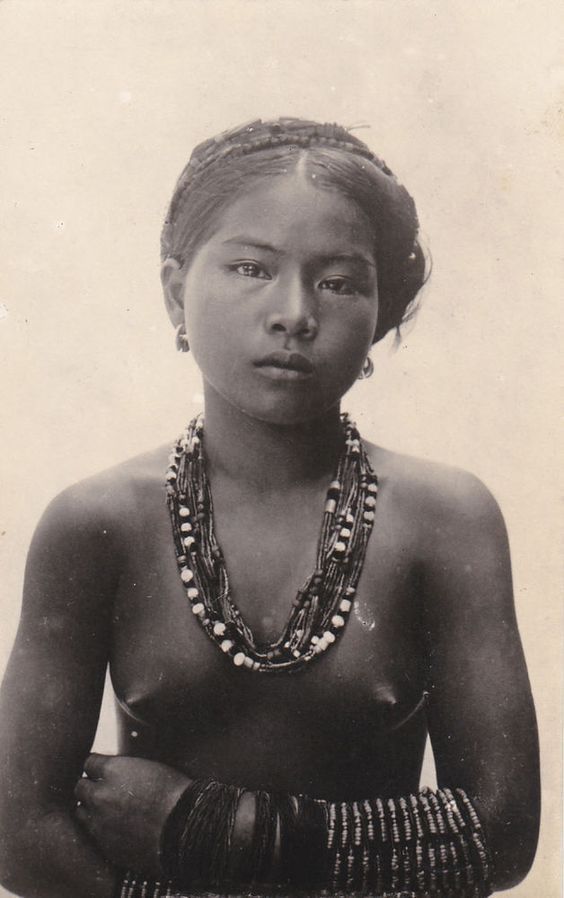
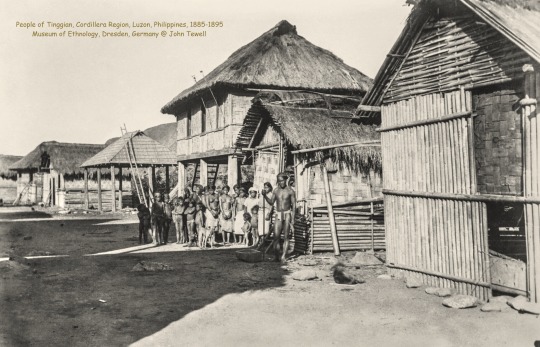
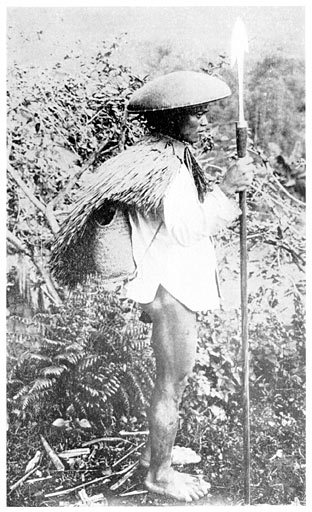
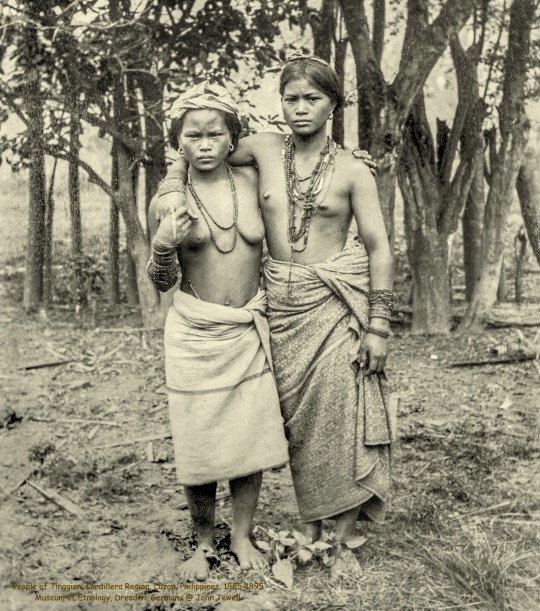
The Itneg people, also known by the Spanish word Tinguian or “Mountain Dwellers”, are an ethnic group from the upland province of Abra in northern Luzon, Philippines.
Through immigrating higher into the mountains, they eventually descended from the Kalinga, Apayao and Kankana-ey tribes to form their own distinct culture, and have divided further into another 9 subgroups.
The Itneg inhabit a deeply spiritual world, where many day-to-day activities such as growing food, hunting and building dwellings are deeply interwoven with their connection to the spirit world. To the Itneg, there are two distinct classes of spiritual beings: natural spirits, who have existed eternally, and the spirits of the dead, who reside forever in Maglawa, a place between the Earth and the Sky. Natural spirits include the creator Kadaklan who watches over all things, Kabonīyan who guides and offers assistance, and Alan, a mischievous but kind half human half bird-being. Periodically, these beings are addressed through ritual, which often includes music, prolonged dancing and the sacrifice of pigs, where the blood is mixed with rice and offered to the gods.
Women often wear a tapis, a wrap-around skirt that reaches below the knees, and a ceremonial short-sleeved jacket. Beads are highly important to the Itneg, signifying wealth and social status, and often accompany rituals such as engagement, where bracelets of colourful beads are curated by men to prove their affection to their potential bride. Men wear a ba-al to cover their privates, a long-sleeved jacket for ceremony and hunting, and a large, dome-shaped hat. Hunting and fishing are sacred practices for men, who employ snares and woven basket traps to catch small game and freshwater eels, fish and crustaceans. Most important of all weapons is the lance or pīka, a long spear used for hunting pigs and in defending their land from neighbouring tribes. The blade of the pīka is extremely sharp and often barbed, and often has a metal or material covering, allowing it to be used effectively as a staff for mountain climbing. Some subgroups utilised a detachable blade, which, attached to the handle with a heavy line, would stay stuck into the animal and as it attempted to escape, would become increasingly entangled as the line was dragged through the undergrowth.
The Itneg cultivate a variety of different fruits and vegetables, including yams, sweet potato, coconut, mango and bananas. Of all crops, however, rice is the most valuable. Cultivated traditionally in wet terraces, rice forms not only the staple of their diet, but the centerpiece of many rituals and customs. Furthermore, basi, a liquid of fermented sugar-cane juice and cinnamon, is used both ritualistically and as a recreational intoxicant. Besides being used to wish for health and well-being to a newly married couple, basi is used as an offering to bring protection from spirits of the dead, and as a tool in ceremony to achieve spirit possession, where one of the many natural spirits uses the body of a shaman as a medium to communicate to the mortals of the tribe.
Today, although subject to attempted colonization by the Spanish and Americans, many Itneg continue to practice their traditional lifestyle in their mountainous homelands of northwestern Luzon. They currently number approximately 50,000 individuals, or 3.17% of the population of Abra.
2nd and 4th photos c. 1885, Museum of Ethnology, Dresden.
1st and 3rd photos source unknown.
499 notes
·
View notes
Text

Itneg Binakol (kusikos detail)
#itneg#binakol#fabric art#indigenous philippines#indigenous#indigenous art#fabric#kusikos#mga arte#philippines#pattern#art
19 notes
·
View notes
Text

According to Itneg or Tinguian (ethnic group from the upland province of Abra in northwestern Luzon, Philippines) myths, Giambolan was a giant headhunter who had ten heads. He had a huge shield and was armed with a head-axe and a spear. A giant boar’s tusk adorned his armlet. Giambolan was the lord of a place called Kaboyboyan where a beautiful spring flowed. One day he was challenged to a fight by two little boys, Ilwisan and Dondonyan who were both created by alans from menstrual blood. With the help of their magical weapons, the boys were able to slay Giambolan.
#Philippine mythology#Filipino mythology#Philippine folklore#Filipino folklore#Giambolan#alan#giants#monsters#alamat#Itneg mythology#Tinguian mythology
10 notes
·
View notes
Photo
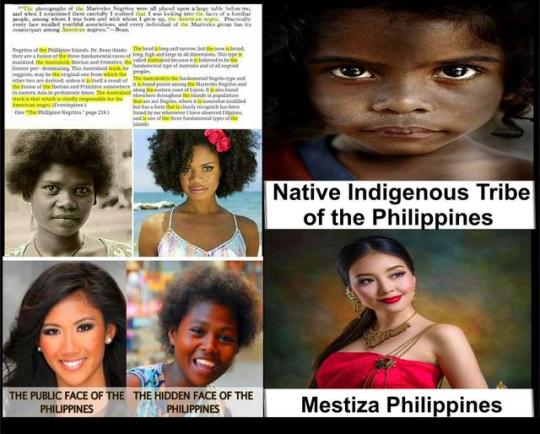
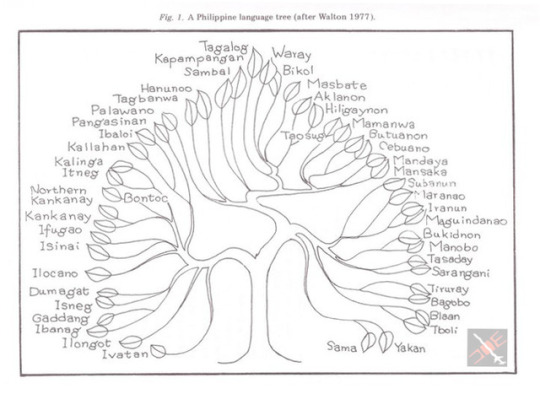
The Aboriginal people of the Philippines7 million indigenous peoples, Luzon
Agta Cayagan
Agta Casiguran
Aeta
Pakkak Gadang
Pugot, N. Apayao
Negritos
Apayao Isnag
Gaddang
Ibanag
Ilongot
Itneg (Tingian)
Malaweg
Paranan
Bontok
Ifugao
Igorot
Isneg
Itneg
Kalinga
Kankanay
Tinggian (= Itneg)
Visayas
Batak
Palawan
Tagbanwa
Taut’ batu
Ata du sud, A. du nord
Magahat Bukidnon
Alangan
Buhid
Hanunòòo
Tadyawan
Taubuid (= Batangan)
Iraya
Ratagnon, Loktanon
Mindanao
Mangwanga
Tasaday (Manobo Cotabato)
Mamanwa
Manobo Ata
Ata Manobo
Bagobo
Blaan
Blit (Manobo Cotabato group)
Bukidnon
Ilanon Manobo
Ilianen
Magindanao
Mandaya Cataelano
Mandaya Sangab
Manobo-Cotabato
Manobo
Mansaka
Subanon
Subanon, Tuboy Salog
Tagabawa
Tboli
Tigwa
Tiruray
Ubo Manobo
Who are Indigenous Peoples
Called Tribal Peoples, First Peoples, Native Peoples, Indigenous Peoples constitute about 5% of the world’s population, yet account for about 15% of the world’s poor.
a member of a black people of
short stature native to the
Austronesian region.
(Oxford Dictionary)
Negrito
called Aeta in Luzon and Ati in Panay.
They are nomadic and build only temporary lean-to-shelters made of two forked sticks driven to the ground and covered with the palm of the banana leaves.
Indonesians
Literally, an indigene, or native. In the colonial era, the great majority of the population of the archipelago came to regard themselves as indigenous, in contrast to the nonindigenous Dutch and Chinese (and, to a degree, Arab) communities. After independence the distinction persisted, expressed as a dichotomy between elements that were pribumi and those that were not. The distinction has had significant implications for economic development policy
—Indonesia A Country Study
yellow to light brown to very dark brown or black skin color
Malay variety. Tawny-coloured; hair black, soft, curly, thick and plentiful; head moderately narrowed; forehead slightly swelling; nose full, rather wide, as it were diffuse, end thick; mouth large, upper jaw somewhat prominent with parts of the face when seen in profile, sufficiently prominent and distinct from each other.
Malay
This last variety includes the islanders of the Pacific Ocean, together with the inhabitants of the Mariannas, the Philippine, the Molucca and the Sunda Islands, and of the Malayan peninsula. Luzon:
Agta Cayagan
Agta Casiguran
Aeta
Pakkak Gadang
Pugot, N. Apayao
Negritos
Apayao Isnag
Gaddang
Ibanag
Ilongot
Itneg (Tingian)
Malaweg
Paranan
Bontok
Ifugao
Igorot
Isneg
Itneg
Kalinga
Kankanay
Tinggian (= Itneg)
Visayas:
Batak
Palawan
Tagbanwa
Taut’ batu
Ata du sud, A. du nord
Magahat Bukidnon
Alangan
Buhid
Hanunòòo
Tadyawan
Taubuid (= Batangan)
Iraya
Ratagnon, Loktanon
Mindanao:
Mangwanga
Tasaday (Manobo Cotabato)
Mamanwa
Manobo Ata
Ata Manobo
Bagobo
Blaan
Blit (Manobo Cotabato group)
Bukidnon
Ilanon Manobo
Ilianen
Magindanao
Mandaya Cataelano
Mandaya Sangab
Manobo-Cotabato
Manobo
Mansaka
Subanon
Subanon, Tuboy Salog
Tagabawa
Tboli
Tigwa
Tiruray
Ubo Manobo
Who are Indigenous Peoples?
Called Tribal Peoples, First Peoples, Native Peoples, Indigenous Peoples constitute about 5% of the world’s population, yet account for about 15% of the world’s poor.
a member of a black people of
short stature native to the
Austronesian region.
(Oxford Dictionary)
Negrito
*called Aeta in Luzon and Ati in Panay.
They are nomadic and build only temporary lean-to-shelters made of two forked sticks driven to the ground and covered with the palm of the banana leaves.
Indonesians
Literally, an indigene, or native. In the colonial era, the great majority of the population of the archipelago came to regard themselves as indigenous, in contrast to the nonindigenous Dutch and Chinese (and, to a degree, Arab) communities. After independence the distinction persisted, expressed as a dichotomy between elements that were pribumi and those that were not. The distinction has had significant implications for economic development policy
—Indonesia: A Country Study
*yellow to light brown to very dark brown or black skin color
Malay variety. Tawny-coloured; hair black, soft, curly, thick and plentiful; head moderately narrowed; forehead slightly swelling; nose full, rather wide, as it were diffuse, end thick; mouth large, upper jaw somewhat prominent with parts of the face when seen in profile, sufficiently prominent and distinct from each other.
Malay
This last variety includes the islanders of the Pacific Ocean, together with the inhabitants of the Mariannas, the Philippine, the Molucca and the Sunda Islands, and of the Malayan peninsula. Ang mga taong Aboriginal ng Pilipinas7 milyong mga katutubong mamamayan, Luzon
Agta Cayagan
Agta Casiguran
Aeta
Pakkak Gadang
Pugot, N. Apayao
Negritos
Apayao Isnag
Gaddang
Ibanag
Ilongot
Itneg (Tingian)
Malaweg
Paranan
Bontok
Ifugao
Igorot
Isneg
Itneg
Kalinga
Kankanay
Tinggian (= Itneg)
Visayas
Batak
Palawan
Tagbanwa
Taut 'batu
Ata du sud, A. du nord
Magahat Bukidnon
Alangan
Buhid
Hanunòòo
Tadyawan
Taubuid (= Batangan)
Iraya
Ratagnon, Loktanon
Mindanao
Mangwanga
Tasaday (Manobo Cotabato)
Mamanwa
Manobo Ata
Ata Manobo
Bagobo
Blaan
Blit (grupo ng Manobo Cotabato)
Bukidnon
Ilanon Manobo
Ilianen
Magindanao
Mandaya Cataelano
Mandaya SangabManobo-Cotabato
Manobo
Mansaka
Subanon
Subanon, Tuboy Salog
Tagabawa
Tboli
Tigwa
Tiruray
Ubo Manobo
Sino ang mga Indigenous Peoples
Tinatawag na Mga Tao ng Tribo, Unang Tao, Katutubong Katutubong, Katutubong Katutubo ay bumubuo ng 5% ng populasyon sa mundo, gayunpaman ay tungkol sa 15% ng mga mahihirap sa mundo.
isang miyembro ng isang itim na tao ng
maikling tangkad katutubong sa
Austronesian region.
(Diksyonaryo ng Oxford)
Negrito
na tinatawag na Aeta sa Luzon at Ati sa Panay.
Ang mga ito ay mga nomadic at nagtatayo lamang ng mga pansamantalang mga lean-to-shelter na binubuo ng dalawang magkahiwalay na stick na hinimok sa lupa at tinatakpan ng palad ng dahon ng saging.
Indonesians
Literal, isang indigene, o katutubong. Sa panahon ng kolonyal, ang malaking mayorya ng populasyon ng kapuluan ay dumating upang isaalang-alang ang kanilang sarili bilang katutubong, kabaligtaran sa mga di-katutubo na Dutch at Chinese (at, sa isang degree, Arab) na komunidad. Matapos ang kalayaan ang pagkakaiba ay nagpatuloy, ipinahayag bilang isang dikotomya sa pagitan ng mga elemento na pribumi at yaong hindi. Ang pagkakaiba ay may makabuluhang implikasyon para sa patakaran sa pagpapaunlad ng ekonomiya
-Indonesia Isang Pag-aaral ng Bansa
dilaw hanggang sa maputing kayumanggi hanggang sa madilim na kayumanggi o itim na kulay ng balat
Malay variety. Kulay ng Tawny; buhok itim, malambot, kulot, makapal at sagana; katamtaman ang ulo; noo bahagyang maga; puno ng ilong, sa halip malawak, tulad ng ito ay nagkakalat, dulo makapal; bibig malaki, itaas na panga medyo kitang-kita sa mga bahagi ng mukha kapag nakita sa profile, sapat na kilalang at naiiba mula sa bawat isa.
Malay
Kabilang sa huling pagkakaiba-iba na ito ang mga taga-isla ng Karagatang Pasipiko, kasama ang mga naninirahan sa Mariannas, ng Pilipinas, ng Molucca at ng mga Isla ng Sunda, at ng peninsula ng Malayan. Luzon:
Agta Cayagan
Agta Casiguran
Aeta
Pakkak Gadang
Pugot, N. Apayao
Negritos
Apayao Isnag
Gaddang
Ibanag
Ilongot
Itneg (Tingian)
Malaweg
Paranan
Bontok
Ifugao
Igorot
Isneg
Itneg
Kalinga
Kankanay
Tinggian (= Itneg)
Visayas:
Batak
Palawan
Tagbanwa
Taut 'batu
Ata du sud, A. du nord
Magahat Bukidnon
Alangan
Buhid
Hanunòòo
Tadyawan
Taubuid (= Batangan)
Iraya
Ratagnon, Loktanon
Mindanao:
Mangwanga
Tasaday (Manobo Cotabato)
Mamanwa
Manobo Ata
Ata Manobo
Bagobo
Blaan
Blit (grupo ng Manobo Cotabato)
Bukidnon
Ilanon Manobo
Ilianen
Magindanao
Mandaya Cataelano
Mandaya SangabManobo-Cotabato
Manobo
Mansaka
Subanon
Subanon, Tuboy Salog
Tagabawa
Tboli
Tigwa
Tiruray
Ubo Manobo
Sino ang mga Indigenous Peoples?
Tinatawag na Mga Tao ng Tribo, Unang Tao, Katutubong Katutubong, Katutubong Katutubo ay bumubuo ng 5% ng populasyon sa mundo, gayunpaman ay tungkol sa 15% ng mga mahihirap sa mundo.
isang miyembro ng isang itim na tao ng
maikling tangkad katutubong sa
Austronesian region.
(Diksyonaryo ng Oxford)
Negrito
* na tinatawag na Aeta sa Luzon at Ati sa Panay.
Ang mga ito ay mga nomadic at nagtatayo lamang ng mga pansamantalang mga lean-to-shelter na binubuo ng dalawang magkahiwalay na stick na hinimok sa lupa at tinatakpan ng palad ng dahon ng saging.
Indonesians
Literal, isang indigene, o katutubong. Sa panahon ng kolonyal, ang malaking mayorya ng populasyon ng kapuluan ay dumating upang isaalang-alang ang kanilang sarili bilang katutubong, kabaligtaran sa mga di-katutubo na Dutch at Chinese (at, sa isang degree, Arab) na komunidad. Matapos ang kalayaan ang pagkakaiba ay nagpatuloy, ipinahayag bilang isang dikotomya sa pagitan ng mga elemento na pribumi at yaong hindi. Ang pagkakaiba ay may makabuluhang implikasyon para sa patakaran sa pagpapaunlad ng ekonomiya
-Indonesia: Pag-aaral ng Bansa
* dilaw hanggang sa maputing kayumanggi hanggang sa madilim na kayumanggi o itim na kulay ng balat
Malay variety. Kulay ng Tawny; buhok itim, malambot, kulot, makapal at sagana; katamtaman ang ulo; noo bahagyang maga; puno ng ilong, sa halip malawak, tulad ng ito ay nagkakalat, dulo makapal; bibig malaki, itaas na panga medyo kitang-kita sa mga bahagi ng mukha kapag nakita sa profile, sapat na kilalang at naiiba mula sa bawat isa.
Malay
Kabilang sa huling pagkakaiba-iba na ito ang mga taga-isla ng Karagatang Pasipiko, kasama ang mga naninirahan sa Mariannas, ng Pilipinas, ng Molucca at ng mga Isla ng Sunda, at ng peninsula ng Malayan.
#Agta Cayagan Agta Casiguran Aeta Pakkak Gadang Pugot N. Apayao Negritos Apayao Isnag Gaddang Ibanag Ilongot Itneg (Tingian) Malaweg Paranan#aboriginal pilipinas#aboriginal philippines#aborigeni filippine#aboriginal#aborigeni#native pilipinas#native philippines#pg#philippines tribu#philippines tribe
3 notes
·
View notes
Text
a non-filipino's guide to trese: ep 1
So some of my mutuals decided to check out Trese aka the Netflix adaptation of the Filipino horror comic book series that I keep rambling about here and then since well um most of my mutuals aren’t from the Philippines fshfs I decided to make a long-ass post that basically consists of me rambling about the cultural context present in Trese with fun little tidbits about Filipino folklore. I’m not an expert on Filipino mythology so um I just typed out the stuff that I know and the stuff that I looked up on Wikipedia so um take this with a grain of salt aaaaa I’ll save the extensive google scholar research ramble on folklore present in Trese for another day.
I’ll try to find the sites where I got some of the information from cause um yea I kinda had a bit of a hard time finding the other shit so um once again, take the stuff here with a grain of salt. Also, feel free to add more info if you guys got any!
SO ANYWAYS ENJOY ME RAMBLING ABOUT EPISODE 1 OF TRESE WOO
+ MRT and LRT (Manila Metro Rail Transit and Light Rail Transit) are train systems in NCR (the capital region) and yea them suddenly stopping and malfunctioning in the middle of the goddamn rail is a daily occurrence and we have been trying to deal with this bullshit for years but alas, corruption and negligence are sweet sweet drugs.
+ When the MRT broke down, you'd see a red bee in the flashing billboard right? Well that's Jollibee and that's probably the most well-known fast food restaurant chain here heck there are even branches of it abroad!
+ According to many youtube comments along with other social media posts that I am way too tired to link here, the opening theme is an Ifugao ethnic song called Balluha'd Bayyauhen but with modern accompaniments and I think the song is about a fruit called a balluha that the character in the song tries to it but cannot swallow. (someone please correct me if I’m wrong here fjkfs)
+ The first um monster that we see Alexandra interact with is the White Lady of Balete Drive. White Ladies or “Kaperosa” are a type of female ghosts typically dressed in ghostly white dresses or similar garments. According to legend, she died in a car accident while driving along Balete Drive (a two lane street formerly lined with Balete Trees which are said to be a home for spirits and mysterious creatures) in Quezon City while other accounts say she died waiting for the arrival of her lover; others also say that she was a teenage girl who was run over and killed by a taxi driver at night and then buried around a Balete tree while another variation of the tale claims that a student from the University of the Philippines was sexually assaulted and killed by a taxi driver nearby and so said ghost haunts the street in search of her murderer. There are many other variations but according to local rumor, the legend was fabricated by a reporter in 1953 in order to make an interesting story. What remains consistent in many variations is that apparently taxi drivers would be stopped by a beautiful lady asking for a ride and if one would look at the rear window, they would see that the white lady in question is bruised and drenched in blood.
+ There are a lot of mentions about "lakans" and stuff in reference to Alex and her father right? In precolonial times, the term is used to refer to the paramount ruler or the highest-ranking political authorities in Tagalog communities (so um NCR and some parts of Region 4). In Muslim communities, they are called sultans while communities with strong trade connecitons with Indonesia or Malaysia called them Rajah. Datu is umm the more generalized term though when it comes to discussing the leaders of the precolonial Filipinos.
+ So, Alex’s mom is a babaylan and back in the pre-colonial period, each barangay (which a native filipino term for a village or a district; said term is still used today to describe um divisions in municipalities like) had them and these are basically Philippine shamans and they specialized in communicating with the spirits of the dead. To my knowledge, the role of babaylan went to women and yea people assigned male at birth but then identified as female were also allowed to become babaylans and they would be treated with the same respect given to any woman back then (honestly I dunno much about lgbtq+ stuff back in the precolonial times but all I know is that precolonial Filipinos were much a lot more welcoming towards trans identities bUT THEN THE SPANIARDS CAME AND UM ERR RUINED THAT); also the writing Alexandra's mom did in that one scene with the dagger is in Baybayin - preHispanic Filipino script. I dunno what she wrote down though. .
+ Also I kinda find it funny that the people here esp those who were at the White Lady scene are um,,, not at all surprised? Like yea quite a number of filipinos have their own superstitions and beliefs and all that but um yea the people in Trese seem very used to the bullshit,,,which in retrospect, isn't at all inaccurate fsdfd I MEAN WE DEAL WITH UNSURMOUNTABLE AMOUNTS OF BS ON A DAILY BASIS SO I DON’T THINK DEAD GHOSTS WOULD EVEN FAZE MANY FSKJDS
+ The one that appears right before Alexandra talks with the duwende (the one in the manhole) is called Laman Lupa (which i guess translates to um "What is in the earth"? just um YEA THEY ARE DIRT CREATURES). normally this is an umbrella term for duwendes and nunos but in Trese they are servants of these aforementioned creatures.
+ Duwende (which came from the Spanish phrase "dueno de case" which means "owner of the house") or dwarves in Filipino folklore are known to be mischievous and magical environmental guardians. They are believed to reside in trees or under earth mounds (those that live in the latter are called nuno sa pundo or old man of the mount) which is why quite a lot of Filipinos say "tabi tabi po" or “excuse me” when wandering around a forest or earth mounds as a sign of respect and in the hopes the duwende won't torment them. If the person is friendly, the duwende can also be friendly in return and will bring that person good lucl; otherwise, those who destroy their homes by stepping on them will face their wrath in form of heartless curse and predictions of ominous and disastrous fates. A duwende's color also depends on their budhi or conscience: to my knowledge, white duwendes are kind, red ones give protection amulets, green ones are firnedly with children and the black ones give nothing but trouble.
+ Chocnut aka the snack Alex bribes the nuno with is a very yummy chocolate snack made of coconut milk, crushed peanuts and cocoa powder. They are umm about an inch in length and maybe half an inch in width so it's fairly small; that being said I WANT THE CHOCNUT THAT ALEXANDRA HAS CAUSE HOT DAMN THAT'S A BIG CHOCNUT
+ In Trese, the creatures in the MRT scene and in the warehouse Alexandra visits after she talks with the duwende are called "aswang". In Philippine folklore, it is an umbrella term for any kind of monster so um an aswang in Luzon would be very different from the aswang in Mindanao. According to what I saw on wikipedia, they can be classified in 5 categories: the vampire (self-explanatory um they drink blood), the viscera sucker (the manananggal, i'll get to that next time), the weredog (cats and pigs are also possible but um yea they target pregnant women), the witch (self-explanatory boom curses and stuff) and the ghoul (they gather near trees in cemeteries to feast on human corpses). Aswangs are often described to have a long, hollow tongue, sharp claws and sharp teeth, although they do also have human forms.
+ To my knowledge, Ibwa, the leader of the aswangs in the warehouse, is a creature from Tinguian or Itneg mythology (they, like the Ifugao, are an indigenous ethnic group in northwestern Luzon) though I could be wrong about this dksfsf Ibwa seems like an ethnic filipino term tho wah I can't remember where I once read that. But anyways, Ibwa often stalk sthe house of a dying person to steal its body. In order for the ibwa to NOT succeed in that, some people burn holes in the garments of the dead and put a sharp iron object on top of the grave since those are most powerful weapons against aswangs which is what Alexandra uses to subdue the Ibwa and kill all the other aswangs (the knife alex uses is named Sinag which means "ray of light".)
+ ALSO I AM SO SO GLAD THEY KEPT THE FILIPINO SWEARS IN THE ENGLISH DUB YES YES THIS IS A VERY GOOD JOB so lemme discuss the versatility of tangina-
+ Also umm Bossing is a nickname of Vic Sotto - one of the three pioneer hosts of Eat Bulaga! which is the longest running Philippine noontime variety show. Over time, most probably due to the show's popularity, the term "bossing" then became um slang for "boss" or "chief"
+ Translation of what Alex says when she's stirring the eye inside the cup: “In the eyes of others, secrets will reveal themselves.”
+ Sidenote: The English dub's pronunciation of many of the tagalog lines are um yea they r pretty good but they could use a bit of work but then again I'm really not that good in speaking in Tagalog so who am I to judge gkdkf sorry po guys conyo po ako-
+ Maria Makiling is arguably the most famous of all the diwatas (ancestral spirits, nature spirits, or deities) in Philippine Mythology; she is associated with Mount Makiling in Laguna as the guardian spirit of the mountain. Mount Makiling is said to resemble a profile of a woman and people associate the profile with Maria herself. She is also known as a goddess by the name of Dayang Masalanta and people would pray to her for safety and to stop storms and earthquakes. That's the goddess Alexandra's mother mentions right when she tells Alex to hide. (Translation to what she said there: Maria Makiling, goddess of the mountain, bless us.)
+ ALSO YEA THAT MAYOR IN THE MRT STATION IS UMMM RATHER REMINISCENT OF MAAAANY POLITICIANS AND PUBLIC SERVANTS HERE LIKE BELIEVE ME I CAN THINK OF SO MANY NAMES RN. THEY WOULD FLAUNT THEIR MACHISMO AND PROMISE THAT THEY THEMSELVES SHALL PUNISH THE PERPETRATORS HARSHLY BUT IN THE END THEY DONT MEAN SHIT AND ARE IN OFFICE TO SERVE ONLY THEMSELVES AND TO SHIT ON THE REST ESP THOSE OF THE POORER SECTORS AND *NOTHING IS DONE ABOUT IT*. WE LIVE IN HELL OKAY. also hmm how the police are represented here is umm,,,interesting,,, like i know there are sOME good police officers like the ones alexandra assists but like,,,our current sociopolitical climate + the many cases showcasing the corruption in the police force + tHE SHEER AMOUNT OF POLICE BRUTALITY HERE would ummm beg to differ. but um anyways-
+ Also Mang Inasal posters can be seen in the MRT station backdrops and um it’s a very famous restaurant chain here and they serve lots of barbecue and other filipino stuffs and i miss them a lot God their halo halo is very yummy
+ Santelmo - oki so this is the fire face thingy that Alexandra summons inside the ruined train. This is the shortened version of the term "Apoy ni Santa Elmo" or "St. Elmo's Fire" - this is a weather phenomenon wherein plasma is created from an electrical discharge from a rod like object in an atmospheric electric field. This phenomenon was used to warn of imminent lightning strikes or storms (there is a chapter in Noli Me Tangere where Pilosopo Tasyo talks about that bUT I'LL SAVE THE NOLI ME TANGERE RAMBLES FOR ANOTHER DAY). But according to Philippine folklore, santelmos - which are said to be souls of people lost as sea - are balls of fire that appear where accidents or big arguments happen. In Trese, santelmos (alex's santelmo being "The Great Spirit of the Binondo Fire") can be called to assist in supernatural investigations
+ Translation of what Alex says when she draws the circles to meet with the purple ghosts: "Souls, where are you off to? I'll be entering too, so please open the door."
+ Remember the scene at the train with all the purple ghosts and the woman in a veil? Yea the woman is an emissary of a goddess named Ibu and she is the Manobo (again, another indigenous ethnic group but this time they're from Mindanao; fun fact we have around 134 ethnic groups) goddess of deceased mortals and the queen of the underworld; she also serves as a psychopomp and guides the newly deceased souls to the other side (having an MRT be the ride to the underworld isn’t in the legends tho so fkkjsf)
+ The aswang in the top hat is called Xa Mul and according to the Isneg/Apayao people (yay another ethnic group but this time in northern Luzon - the Cordillera regions to be specific), they are an evil spirit known to swallow people whole.
+ Alex has two henchmen right? Yea they are named Crispin and Basillio and No I still don’t know who’s who and I'm really sorry about that fsfjs so anyways the names Crispin and Basillio are actually those of two brothers featured in the Noli Me Tangere and El Filibusterismo novels (Crispin is younger and Basilio is older) which are basically the national novels here cause um yea written by national hero Jose Rizal as sociopolitical commentary about the Spanish regime here. I don't know if I want to spoil this cause I kinda want other people to read the novel too fskfs BUT ALL IN ALL, ONE OF THEM DIES IN LIKE THE 10TH OR 11TH CHAPTER OF NOLI ME TANGERE (and the novel has 64 chapters btw) AND UM YEA-
+ OKI SO TO ADD MORE CONTEXT TO THE SQUATTER STUFFS MENTIONED IN TRESE (we r gonna use the tiny font here because holy shit this rant is long): So,in the Philippines, especially in the capital region, there are lots of slum areas called squatters. These are dense urban settlements made of compact makeshift housing units that aren't really officially recognized by the government. This is um very reflective of the poverty situation here and there are maaany factors that come into play here and if i were to go into depth about this topic, that rant would probably turn into an academic paper so for the sake of brevity, let's just say that Things Are Fucked Up Here. Oftentimes the poorer sectors are being ignored and left to their own devices despite tons of campaign promises to make things better and easier for them. The communities that live here are incredibly vulnerable to floods, fires, and the like and afaik no concrete solutions have been in effect to protect these people and their settlements. There have also been many times where squatter areas are dismantled or demolished despite protests of people living in those areas and yea I understand the need to make space and the need for renovation but the people should still be offered some sort of temporary settlement or financial compensation thingy that doESN'T fuck them over but alas, we have an anti-poor government. That being said, I really like Trese Ep 1's portrayal of governmental negligence, but I also have some thoughts, especially in regards to the mayor being arrested THAT FAST which um believe me, NEVER FUCKING HAPPENS BECAUSE MANY MAYORS AND A LOT OF POLITICIANS HAVE THE POLICE IN THEIR POCKETS SO UM ERR YEA JUSTICE IS RARELY A THING HERE BUT UM ANYWAYS YEA THE GOVERNMENT LIKES TO SHIT ON THE POOR WOO LET'S SAVE THE USE OF SOCIOLOGICAL LENS ON THIS MATTER FOR ANOTHER DAY
+ The news channel reporting the arrest of the mayor is ABC-ZNN WHICH IS AN OBVIOUS REFERENCE TO ABSCBN aka the top media conglomerate here (that has been fucked over by the government so many times to the point that they had to shut down operations last year which is all sorts of unfair so seeing them being referenced here kinda made me happy gksfks)
#HI PATROC I HAVE A GIFT#IT'S A VERY LONG AND CONVOLUTED GIFT#BUT IT'S A GIFT#I WISH YOU THE BEST OF LUCK IN TRYING TO UNDERSTAND THIS#this is literally 2813 words long AND IT TOOK ME 12 HOURS TO TYPE THIS OUT OH GOD#AND THIS IS JUST EP 1#here's to hoping the following eps are gonna be much easier for me to like ramble about considering that i explained quite a lot here gfsfs#please do take this ramble with a grain of salt tho cause obviously I am not a mythology expert so um feel free to add more info!#i'd really love to see more info about trese so yay!#trese#trese netflix#alexandra trese#trese spoilers#ask to tag
103 notes
·
View notes
Photo

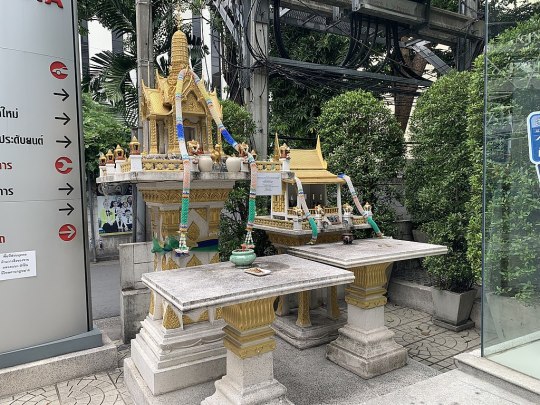
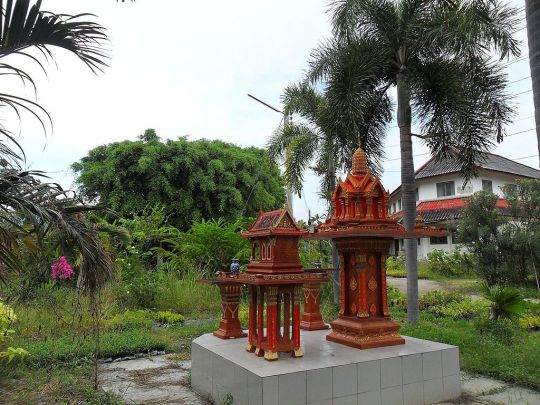

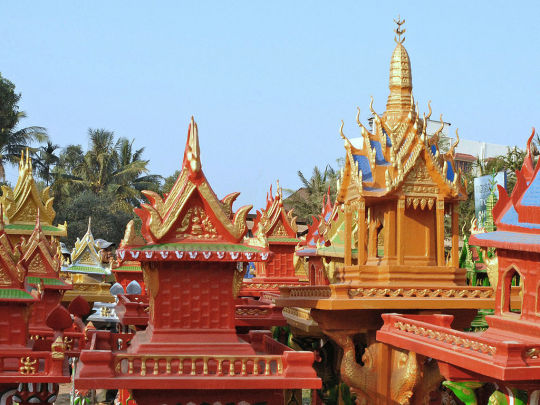
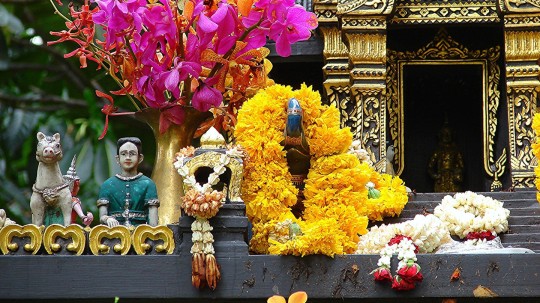

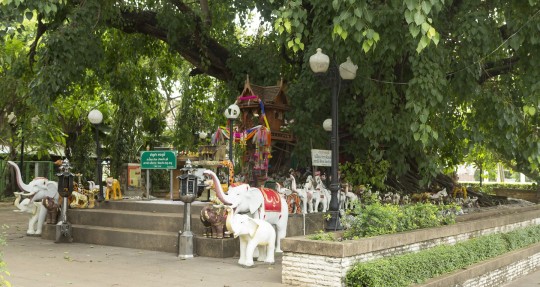

1-2. Bangkok, Thailand
3. Spirit houses at a private house, Phetchaburi, Thailand
4. Spirit house, Hua Hin
5. Cambodian-style spirit houses
6. Spirit House at U.S. Embassy, Bangkok | © l.hillesheim / Flickr
7. Offerings on a spirit house | © Johan Fantenberg/Flickr
8. A spirit house in Udon Thani | © Stefan Fussan/Flickr
9. A spirit house watches over a rice field
A spirit house is a shrine to the protective spirit of a place that is found in the Southeast Asian countries of Burma, Cambodia, Laos, Thailand, Malaysia, Indonesia, Vietnam and the Philippines. The spirit house is normally in the form of small roofed structure, and is mounted on a pillar or on a dais. They can range in size from small platforms to houses large enough for people to enter. Spirit houses are intended to provide a shelter for spirits that could cause problems for the people if not appeased. The shrines often include images or carved statues of people and animals. Votive offerings are left at the house to propitiate the spirits. More elaborate installations include an altar for this purpose.
In Indochina, most houses and businesses have a spirit house placed in an auspicious spot, most often in a corner of the property. The location may be chosen after consultation with a Brahmin priest. Spirit houses are known as နတ်စင် (nat sin) or နတ်ကွန်း (nat kun) in Burmese; ศาลพระภูมิ (san phra phum, 'house of the guardian spirit') in Thai; and rean tevoda ('place for the tevoda-spirit') or pteah phum in Khmer.
In maritime Southeast Asia, spirit houses are connected to the various traditional animistic rituals involving spirits. In the Philippines, spirit houses are dedicated to ceremonies or offerings involving the anito spirits. They are also referred to as shrines. They are known magdantang in Visayan; ulango or simbahan in Tagalog; tangpap, pangkew, or alalot (for various small roofed altars), and balaua or kalangan (for larger structures) in Itneg; maligai in Subanen; tenin in Teduray; and buis (for those built near roads and villages) and parabunnian (for those built near rice fields) in Bagobo.
In Thailand, it is a long-standing tradition to leave offerings of food and drink at the spirit house. Rice, bananas, coconuts, and desserts are common offerings. Most ubiquitous is red, strawberry-flavoured Fanta. The idea seems to be that friendly spirits will congregate to enjoy free food and drink and their presence will serve to keep more malign spirits at bay. The popularity of red Fanta offerings has existed for decades. Opinions as to "why Fanta?" vary. Most point to the significance of the colour red, reminiscent of animal sacrifice, or perhaps related to the practice of anchoring red incense sticks in a glass of water which promptly tints the water red. Sweetness is explained by the observation that sweet spirits naturally have sweet tooths.
Before you set up a spirit house, you must consult the services of a Brahman priest or Buddhist monk. Not one glove fits all when it comes to finding the correct spirit house; in fact, it is largely dependent on the landlord’s astrological chart to find the perfect match. A Brahman priest or Buddhist monk will also use the owner’s astrology to determine the colour and size of the spirit house and the correct date and time to have the erection ceremony for it. The placement of the spirit house is also extremely important; Thai architects will change their designs to accommodate the auspicious placement of a spirit house on a property. Its location should preferably be in front of a tree, should not be on the left side of a door, and should not face a toilet or a road – these are but a few of the things that need to be taken into consideration when finding the perfect place for a spirit house.
A spirit house should only be put up with an elaborate and sacred ceremony. Family, friends and neighbours are invited, along with invisibles, including angels, gods, house gods and nagas. At the pre-determined date and time, the ceremony begins with auspicious food being laid out, followed by the land buying ritual to show respect to the Goddess of the Earth; she then reciprocates by clearing away negative energy from the land. The Brahman priest or Buddhist monk will then remove any curses or evil spirits on the land by infusing the hole for the pillar with goodness, which means placing nine lucky leaves, flowers and stakes of lucky Lanna-inscribed wood inside of the hole. Added to the mix is a matrix of geometric figures and nine gemstones that relate to the astrological planets.
After some chanting, the attendees then help erect the spirit house in the correct location. Next, the Brahman priest or Buddhist monk calls on the invisible witnesses and does some more chanting to collectively invoke all the energy into a statue of the Hindu angel Phra Chai Mongkon who is believed to protect homes and businesses. This figure holds a money bag and a sword, and once the spirit world’s energy has been directed into the statue, gold leaf is placed on top of it. It is then the landowner’s responsibility to place the statue inside the spirit house. Ceremony attendees then place flowers and some coloured cloth around the shrine, which is followed by the ‘San Jao Tii’ ceremony to let the land gods know that they will honour them. Finally, the Brahman priest or Buddhist monk does some more chanting, and then they sprinkle holy water on the spirit house. And with this, the ceremony closes, marking that the spirits have a new home.
It’s best not to remove a spirit house; spirits are like tenants in that they do not want to be evicted. Traditionally, landowners leave an old spirit house intact and build another one alongside it. If there is no other option, and the shrine must be removed, a ceremony just as auspicious as the birth of a spirit house must take place. A Brahmin priest or Buddhist monk will decide on the correct date and time to remove the spirit house, which is then transported to a blessed spirit house graveyard. The above steps are extremely important as the belief is that if the spirit house does not rest in peace, the landowner is at risk of a lifetime of bad luck.
Among the innumerable variety of phi, or spirits that can inhabit a spirit house, many of which can influence human life, are the ghosts of people killed by animals, women who died in childbirth, and those who perished but didn’t receive a proper burial. Trees are one of the most common places for phi to dwell. A rock, river bend, spring or cave is infused with spiritual properties.

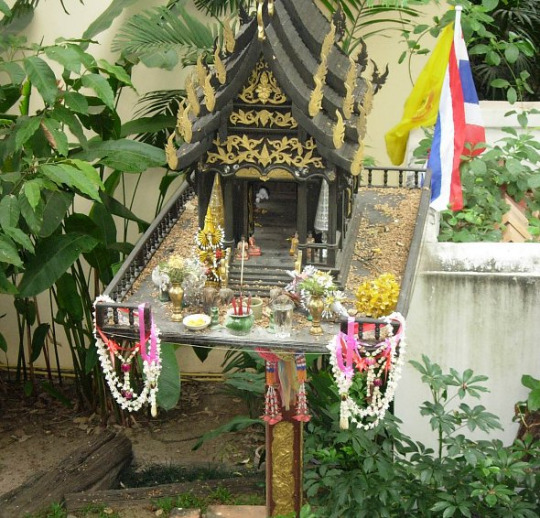
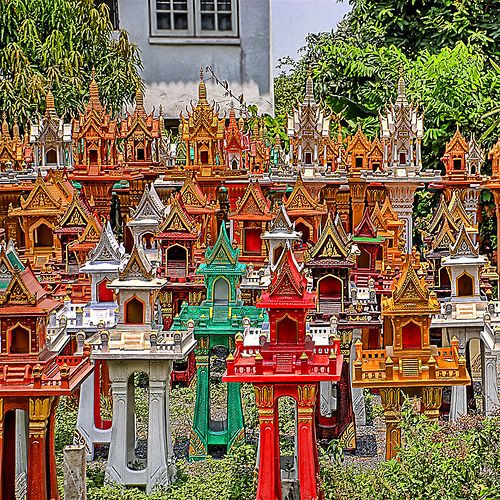








8 notes
·
View notes
Text
PHILIPPINE INDIGENOUS ARTS OF THE CORDILLERA
Cordillera Administrative Region (CAR) consists of the provinces of Abra, Apayao, Benguet, Ifugao, Kalinga, Mountain Province and Apayao. It is rich in ancient culture and is the home of various indigenous groups such as Tinggian, Isneg, Kankanaey, Iyaplay, Bontoc, Ibaloi, Karao, Ifugao, Kalinga, Kankanaey, Kalanguya, Isneg, Igorot, Iyaplay, and Bontoc.
ARTS OF THE CORDILLERA
Sculpture/Carving
Bul-ul

This male figure representing a rice deity (bul-ul) from the Ifugao people of Northern Luzon Island in the Philippines is an outstanding and highly important expression of the foremost tradition of anthropomorphic sculpture in the northern Philippines. Sculpted with exceptional elegance and sensitivity for its genre, it is among the finest expressions of its type.
Hagabi

This is a traditional large ceremonial benches carved for wealthy Ifugao families as a symbol of wealth, power and prestige. The bench serves as a symbol of a prestigious "hagabi feast" in which the carving of the bench marks the beginning of the celebration. In the past, only the the wealthy called 'cadangyans' were allowed to have hagabi which to be used inside their home.
Pottery
Banga

This is an earthen container originated by the northern Cordillera region of the Philippines. Traditionally, they’re made of local clay found only in the Kalinga villages, an area rich with rice terraces and lush mountainsides.
Weaving
Ikat or Ifugao Textile

Ifugao Ikat weaving is a style of weaving that uses a resist dyeing process on either the warp or weft before the threads are woven to create a pattern or design. The result of this process is a motif which is fuzzy in appearance. This blurry look comes from the slight bleeding of the dyes into the resist areas. Ifugao Ikat is characterized by diamond stripes of white and red stripes. It is known for its colors and striking design patterns.
Kalinga Textile

Kalinga hand woven fabrics are characterized by dominant red stripes and motifs of geometric patterns with nature symbols interlaced with white yellow and black fibers. Originally woven in Lubuagan, the “ka-in” (wrap around skirt) is now more known as the Kalinga. The different types of “ka-in” are gilamat, silugwid, pilakpak, gililing, lilaktob and ilaglis. For men’s g-strings, there are the pilagpagen, kilayao and sillayuti. These are traditionally on rituals and special occasions like weddings, festivals, and other important occasions. In Kalinga weaving symbolism, the sky and ground are represented by the colours indigo and red respectively. Mountains are represented in yellow and are embroidered in the fabric. Yellow symbolizes wealth and refer to growth and fertility. Beading is another distinct characteristic of the Kalinga apparel.
Siwsiwan or Bontoc Textile
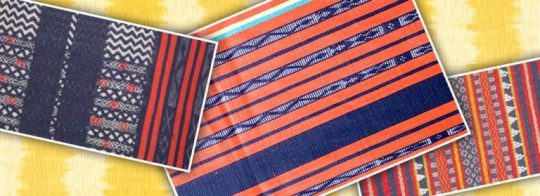
Bontoc hand woven fabrics are characterized by motifs that include geometric shapes of things around them such as man, lizard, mountain, rains and flower. Siniwsiwan is Bontoc’s blanket and clothing. This fabric is used for wanes or men’s G-string (Bahag) and getup or Lufid (Tapis) among women. Married women of Bontoc and Kankanaey wears a type of belt called ginaspala wanes with inawin which is a continuous zigzag pattern.
Tattoo
Chak-lag
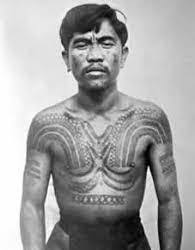
Tattooed on the chest of the head taker.
Pong’-o
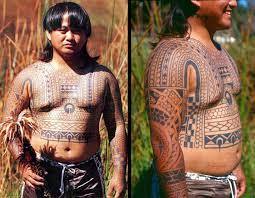
Tattoed on the arms of men and women.
Fa’-tek

All other tattoos of both sexes, but women are allowed only to have tattoos on the arms.
Architecture
Ifugao

Kankana-ey

Kalinga

Bontoc

Isneg/Itneg
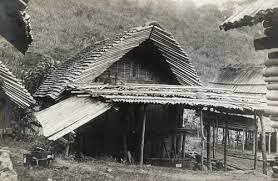
2 notes
·
View notes
Text

Gawa nina Theo Allen T. Nacu at Armhie Fhey C. Sacramento
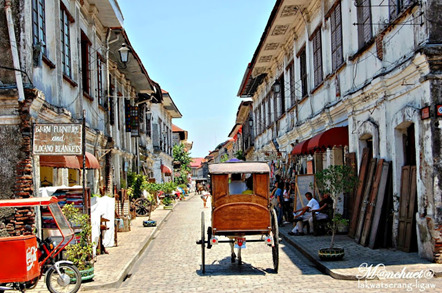
Bata pa lamang ako ay interesado na akong makapunta sa iba’t ibang lugar upang malaman ang mga pangyayaring naganap doon at ang mga masasarap na pagkain na natatangi sa bawat lugar. Noon pa man, gusto ko nang lakbayin ang bawat sulok ng Ilocos Sur upang malaman ko kung ano ang mga mahahalagang nangyari roon at kung anu-ano ba ang aking makikita roon na talagang makakapagpagalak sa akin.


Naaalala ko pa noong panahon na litong-lito ako kung saan nga bang parte ng Pilipinas nakapwesto ang Ilocos Sur, tinawanan pa nga ako ng aking ina noong sinabi ko sa kanya na ito ay nasa bandang Visayas. Ang Ilocos Sur ay isang probinsya na matatagpuan sa lungsod ng Vigan na makikita naman sa rehiyon ng Ilocos na nasa isla ng Luzon. Ang Ilocos Sur ay may kabuuang 2,579.60 kilometro kwadrado at mahigit kumulang 20% ang sakop ng probinsyang ito sa buong rehiyon ng Ilocos. Ang dayalektong kalimitang ginagamit ng mga taong naririhan rito ay Ilocano. Ngunit mayroon pa rin naming ibang lengguwahe o dayalekto na ginagamit ng mga tao rito. Ang mga ito ay English, Tagalog, Chinese, Pangasinense, Kankanai, Tinggian, Muslim, at Visaya.

Dahil nga ang Vigan sa Ilocos Sur ay naging parte na ng Unesco World Heritage List, napakarami ng mga bagay at lugar na maaaring mapuntahan upang makita ang mga natatanging kultura rito. Noong kami ay nagpunta rito, hindi mapagkakaila na talagang inalagaan ang mga bagay na makakapagpaalala sa pagsakop ng Espanya sa lugar na ito. Ang kasaysayan ay talagang naroon pa rin, hindi ito nawala at kitang-kita ito sa mga monumento at mga pagkakatayo ng mga bahay at gusali.

Noong pag-apak ko sa lupa ng Vigan, isa sa pinakamasaysayang lugar sa Ilocos Sur, hindi ako magkamayaw dahil sa aking galak. Tila bang ako’y namumuhay pa sa nakaraang panahon. May mga kalesa, ang mga gusali ay hindi ganoon kamoderno at makikta mong may halo talagang kultura ng Espanya rito. Ang lugar na aming pinuntahan ay ang Calle Crisologo, na tinatawag ding Cobblestone Street, dito makikita ang makukulay na heritage houses na talagang nakatatag na rito mula pa noon. Ito ay inalagaang mabuti kung kaya’t napakaayos pa ng itsura nito. Ngunit bago pa man maging Calle Crisologo ang pangalan ng kalyeng ito, tinawag muna itong Escolta de Vigan nang matagpuan ito ni Juan de Salcedo noong 1572. Ayon sa ilang mga mamamayan na nakasalamuha namin sa kalyeng ito, noong panahon pa raw ng mga Espanyol, ang lugar na ito ay naging sentro ng kalakan ng mga tiga ibang lugar. Mayroon pa nga silang nababanggit na istorya na tila ba teleserye dahil sa nangyari. May mga Pilipina at Hapon na nagkaibigan sa kasagsagan ng pananakop. Ito raw ay mahigpit na ipinagbabawal ngunit matindi raw talaga ang nagagawa ng pag-ibig. Hindi ko ito makalimutan dahil na rin siguro sa aking galak na marinig kong may love story palang nabuo noong mga panahong iyon habang nagaganap ang Ikalawang Digmaang Pangdaigdig.

Makikita rin sa Calle Crisologo ang mga tindahan ng mga pasalubong na pagkain at kagamitan. Napakaganda ng mga tinda rito, ngunit naaalala kong may kamahalan ang mga ito kaya iilan lamang ang pasalubong na nabili namin mula sa tindahang ito. Mayroon pang hanay ng nagtitinda sa kahabaan ng kalyeng ito ngunit halos pare-pareho lamang ang aking nakikitang tinitinda nila.

Hindi ko na rin pinalagpas ang pagkakataon na makasay sa kalesa. Tuwing naaalala ko ang pangyayaring ito, nakakaramdam ako ng awa para sa mga kabayong naamasada roon. Napakaganda ng ideya na sumakay sa kalesa, magpanggap na nasa sinaunang taon ka pa; ngunit pag naiisip ko na ang mga kabayo ay nasa ilalim na sobrang init na sikat ng araw at mabibigat pa ang mga pasaherong sinasakay nito. Pero napapaisip din ako dahil ang kalesa ang nagsisilbing pamumuhay ng ilang mamamayang tiga-Ilocos Sur. May kamahalan din ang pagsakay sa kalesa ngunit masasabi ko na sulit naman ito dahil iba ang pakiramdam kapag naranasan mong sumakay sa isang kalesa. Talagang iba ang nabibigay na kaligayahan ng pagsakay dito.

Pagkatapos ng aming maikling pagsakay sa kalesa, dinala naman kami ng aming mga nahihiwagaang isipan sa isa pa sa mga kilalang atraksyon sa Vigan, ito ay ang kanilang mga liit-liit na mga museong naglalahad ng mga buhay ng mga prominenteng tao at kasaysayan ng kani-kaniyang lugar tulad na lamang ng tanyag na bahay ni Padre Burgos.
Ang bahay na ito ay kilala sa pagiging ancestral house ng mga Burgos at ang lugar ng kapanganakan ng Padre. Ito ay isang dalawang palapag na museo na naglalaman ng kultura ng Ilocos, Kankanay, at Itneg. Sa pagpapakita ng kanilang mga sari-saring kagamitan tulad ng mga platong kahoy, kabaong na yari sa nara, burial chairs, tambur o mga kasangkapang pangmusika, at marami pang iba, naipaparating ang makulay ng kultura hindi lamang ng mga Ilocano kung hindi pati na rin ang mga Pilipino. Ang museo ay mayroon ring lamang dioramas na nagpapakita ng mga local na pagtitipon, litrato ng mga indibidwal na may malaking ambag sa sosyo-kultural na paglago ng rehiyon. At syempre, hindi mawawala ang mga memorabilia ni Padre Burgos at ng kanyang pamilya na nanirahan sa tahanan.

Ilang liko lamang mula sa kilalang museo ay dinala naman kami ng kutsero ng kalesa sa isa pa sa mga tanyag na museo sa loob ng Ilocos Sur, ang Museo ng Crisologo. Ang Museo ng Crisologo ay isa ring ancestral house ng kilalang dating kinatawan ng Ilocos Sur na si Floro Crisologo at ng kanyang pamilya. Ang mga Crisologo ay isa sa mga pinaka tanyag na political family sa probinsya ng kanilang panahon. Ngayon, ang bahay ay nagsisilbing daan upang bisitahin ang nakaraan gamit, memorabilia, kasangkapan, at ang bahay na minsang tinirahan ng mga Crisologo. Sa dinami-dami ng mga kagamitan sa museo, ang pumukaw ng aking pansin ay ang pulang sasakyang ito. Si Gobernador Carmeling Crisologo ay tinambangan sa pulang Chevrolet na ito noong Mayo 10, 1961 sa Bacsil, San Juan, Ilocos Sur. Sa kabutihang palad, siya ay nakaligtas mula sa nabanggit na insidente.

Sa totoo lamang, ito ay isang nakakapangilabot na memorabilia para sa akin. Hindi ko pa rin lubos isipin na kahit sila ay mga kilalang tao, nakasabit pa rin ang kani-kaniyang mga memorabilia na naiwan sa mga nagdaang taon tulad na lamang ng pantalong sinuot ng kinatawan noong siya ay barilin sa simbahan, sasakyang ginamit noong ang gobernadora ay tinambangan. Ngunit ito ay mga bagay na may makukulay na nakaraan at kwentong marahil hindi alam ng karamihan, ito pa rin ay isang karanasang nagbukas sa aking isipan sa ‘lakbay-nakaraang’ ito.


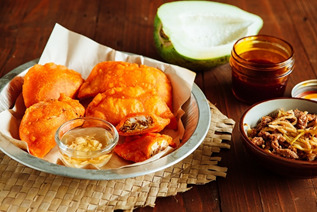
Hindi lamang mga museyo at mga kalyeng puno ng istoryang pang-kasaysayan ang mayroon ang Ilocos, matatagpuan rin dito ang nagsasarapang mga pagkain tulad na lamang ang kanilang empanada at longganisa. Ang empanada ay isang sikat na street food na kalimitang makikita sa mga kalye ng Vigan, Ilocos Sur. Ito ay may dough na gawa sa dinurog na kanin at atsuete para sa kilala nitong kahel na kulay, luntian o hindi pa hinog na papaya, vigan longanissa, at isang itlog na inilagay sa gitna ng filling at isinalang sa kumukulong mantika upang maging malutong. Sa pag kagat mo ng empanada ay siguradong malalasahan ang malutong na dough, malasang Vigan longganisa, at sariwang-sariwang murang papaya na magdadagdag ng “freshness” sa naturang pagkain.

Sa kabilang banda naman, ang Vigan longganisa, tulad ng mga kilala nating longanissa ay mayroon palaman na baboy na mayroong kasamang pampalasa at maraming bawang na nagdadala ng kilala nitong lasa at amoy. Napakasarap nito mag-isa ngunit hindi dapat ito palagpasin ng hindi nalalagyan ng sukang Iloko. Unang kagat pa lamang ay malalasahan mo na ang bawang at siguradong susundan ito ng iba’t iba pang panlasa na ginamit sa baboy sa loob ng longanissa. Tunay ngang napakasarap ng empanada at longganisa sa kahabaan ng kalye at kung papaanong hindi lamang masarap na pagkain ang dala nito kung hindi pati na rin ang kwento ng mga cobblestone pathways sa klaye.

Nang tumagal-tagal ang aming paglalakad sa kahabaan ng Calle Crisologo, napunta naman kami sa isa pa sa mga tanyag na pagkain pinasikat ng Ilocos Sur, ang kilalang Pinakbet Pizza. Aming pinuntahan ang orihinal na gumagawa ng tinaguriang “vegetarian pizza”, ang Café Leona. Ang pizza ang may lamang kamatis, talong, sitaw, bulaklak at mismong bunga ng kalabasa, at higit sa lahat, ampalaya. Kung kaya’t bagamat hindi ako mahilig sa mga gulay, ako pa rin ay magiliw na naghintay sa pizza dahil interesado akong matikman ito at kung tunay nga bang nabago nito ang lasa ng gulay at ito ay napasarap. Tunay nga! Ng aking tikman ang isang slice ng pizza ay napatunayan ko na ito ay hindi lamang masarap kundi masustansya rin.

Tila hindi pa nakuntento ang aming mga kalamnan sa naturang pizza kung kaya’t naghanap pa kami ng kakainin sa kilalang Vigan at natagpuan naman naming ang miki noodles. Ang miki ay isang kilalang sabaw sa Ilocos na may lamang pancit na gawa sa itlog, chicken stock, at para sa kaniyang kilalang kahel na kulay ay mayroon rin itong dinurog na atsuete. Sinangkapan rin ito ng bagnet na nagpalasa at nagbigay ng lutong sa sabaw kung kaya’t mas masarap at mas malasa ito. Napakasarap ng sabaw na ito ay perfect na kasabay ng Vigan longganisa at empanada habang ikaw ay nakaupo sa cobblestone cafes ng kilalang kalye.

Bagaman marami dito ay sa kahabaan lamang ng Calle Crisologo matatagpuan, sigurado naman akong mabubusog ang iyong tiyan at mapupuno pa ito ng makukulay na kwento mula sa mga tindera ng mga kainan at karinderya. Halos lahat ng aming natikman mula sa paglalakbay na ito ay nirekomenda sa amin ng mga nakatira roon ang pinagmamalaking empanada at longganisa ang Ilocos Sur. Talaga nga namang hindi ka magsisisi at babalik-balikan mo ang mga ito. Naaalala ko pa na nagbilin ako sa aking ina na bumili siya ng sariwang longganisa para mayroon kaming iuuwi at iluluto sa bahay.


Sa aming paglalakbay sa loob ng tatlong araw, tila napakaraming kwentong, karanasan, at panlasa ang nagbalik sa akin sa aking kabataan sa Ilocos at nakapagbukas ng aking isipan hindi lamang sa nakaraang mga nangyari dala ng kilalang Calle Crisologo at Museo ng Burgos at Crisologo ngunit pati na rin ang aking pinagmulan. Bagamat lingid sa inyong kaalaman, ako ay isang Ilokano kung kaya’t habang nararamdaman ko na tila ba ako ay isang dayuhan sa aking sariling bayan ay hindi pa rin maalis ang aking pagmamalaki sa aking pinagmulan. Sapagkat sa bawat sulok, kalye, at hapagkainan ng Ilocos Sur ay mayroon kang bagong malalaman hindi lamang mula sa kasaysayan ng mga Ilokano kung hindi pati na rin ang kanilang mga kasanayan kung bakit isa ang Ilocos at Ilocano sa mga tanyag na rehiyon sa Pilipinas. Hindi nga ako nagkamali sa pagpili ng aming paglalakbay patungo sa Vigan, Ilocos Sur kung kaya’t sa aking pagbabalik sa aming tahanan ay may bitbit akong mga bagong kwento, karanasan, panlasa, at mga natutunan na kumilala sa aking nakaraan at patuloy na huhubugin ako sa kasalukuyan at kinabukasan.
Mga Sanggunian:
https://www.lakwatserangligaw.com/2015/10/what-to-see-in-ilocos-sur.html
http://tourism-philippines.com/ilocos-sur/
http://laoag.china-consulate.org/eng/lqjs/gsgk_1/t315270.html
https://www.phbus.com/blog/tourist-spots-vigan-city-2021/
https://www.zenrooms.com/blog/post/calle-crisologo/
https://www.ivanhenares.com/2009/06/longganisa-vigan.html
http://tourism-philippines.com/ilocos-sur/
https://tinyurl.com/4666xajp
https://tinyurl.com/29cg97gj
https://tinyurl.com/w63c4psj
https://tinyurl.com/4vskqu79
https://tinyurl.com/156svrse
https://tinyurl.com/12gl66qd
https://tinyurl.com/5fzxk5jy
https://tinyurl.com/ik4qrewg
#Lakbay Sanaysay#Ilocos Sur#Vigan#Kalesa#Calle Crisologo#Vigan Longganisa#Vigan Empanada#Vegetarian Pizza#Pinakbet Pizza#Museo Crisologo
2 notes
·
View notes
Photo

On this day, 20 September 1763, Filipina revolutionary anti-colonial leader of Itneg and Ilocano mestiza descent, Gabriela Silang, was executed by Spanish authorities. The previous week, she had attempted to besiege Vigan, but she was forced back to Abra, where she was later captured. She and her troops were hanged in Vigan's central Plaza. https://www.facebook.com/workingclasshistory/photos/a.296224173896073/1812334402285035/?type=3
161 notes
·
View notes
Text
Abel: The Ilocano Weaving Industry Amidst Globalization
A Filipino woman weaves in her factory, inheriting a long tradition that may be threatened by the decline of support for local weaving industries in the Ilocos region of the Phillipines.
Weaving in the Philippines is not only a form of art for the native Filipinos, but a part of the way of life that may be traced back to before the Spanish colonization. Weaving is defined as an eminent method of textile production in which two typical sets of yarns or filaments are interweaved at right angles to construct a fabric or cloth. This is a process of intertwining the vertical yarn (warp) and the horizontal yarn (weft), respectively known as gan-ay and pasakan in the Ilocos province.
Native Filipinos use fibers from pineapple, abaca, coconut cotton, bark, and silk to weave different products used for everyday life. These various products include baskets used for capturing fish or storing foods, pieces of clothing called kamiseta and saya (a traditional blouse and skirt for women), other cotton and striped clothes they call as rayadillos, and terlingas, handkerchiefs, and others alike.[2] The manner and the taste of clothing — the materials used, the designs, the embroidery, and its colors — are significant among the indigenous groups because it symbolizes the beliefs and rituals they practice. For example, the indigenous people from the province of Abra, called Itneg, believed that the designs of the textiles they use depicts their high regard for the spirits and gods of the nature that provide them with food and blessings.
Centuries have passed, and the culture of native Filipinos is being molded by time. With the technological innovations in cloth production made during the Industrial Revolution, the industry of weaving dramatically changed. A large complex cloth making industry that uses automated machines to produce textile has evidently played a huge role for the local community in building up and expanding the country’s capability to excel in economic industrialization. Likewise, the weaving industry of the Philippines, with its beauty, uniqueness, and maintained prestige, shows potential for contributing to the economic development of the country.
Currently, local weaving industries are declining, and thus with the aim of preserving the culture of weavers and the commercial benefits of local communities’ weaving, it is necessary to understand firstly the industry’s development and secondly the challenges faced by local weavers.
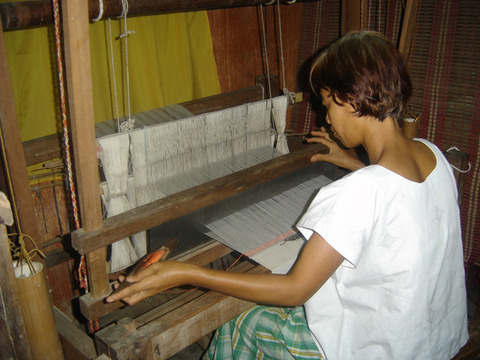
1 note
·
View note
Photo
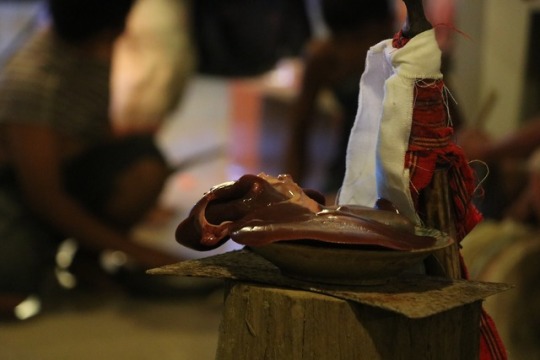

The road to 21AM: CCP announces the de-installation of the pinaing and sunduk exhibitions
A new museum initiated by the Cultural Center of the Philippines (CCP) will be developed and built over a period of a few years. It marks CCP’s 50th anniversary this year, which will have a year-long celebration from September 2019 to September 2020.
The new museum is named 21AM, a 21st century art museum.
21AM was greenlighted as a contemporary art museum that, among other important tasks, addresses the relationship of 21st century artistic idioms and traditional Philippine art. Both physical and intellectual infrastructures for such a museum concept will be built.
It will first reside on the CCP 4th floor space, which housed CCP’s Museo ng Kalinangang Pilipino (MKP) since the latter was established in 1987.
Scheduled for inauguration in May 2020, the concept and initial exhibitions of 21AM will replace the MKP.
Two of exhibits of the MKP are set to be dismantled this month: the exhibit of guardian rocks or pinaing of the Tingguian people in Peñarrubia town, Abra province and the exhibit of grave-markers or sunduk of the Sama Dilaut people in Santa Cruz Island, off of Zamboanga City.
The demounting and storage of the cultural materials will take place after two traditional rites have been performed by leaders from the respective indigenous groups: the pinaing exhibit on October 2; the sunduk exhibit on October 11.
For the pinaing, the son of the ritualist who prayed over the transfer of the materials in 1987, was the central participant. He was joined by family members of the original Tingguian group.
For the sunduk, a Sama ritualist, who is also an imam or a Muslim leader, will conduct the rite of transfer to storage. Among the participants from the Sama area are descendants of at least one individual buried on Santa Cruz Island. Most of the markers have been separated from these graves by a voracious antiquities trade.
While only semi-public, these rituals are held as an official part of the museological procedures covering the managed transition from MKP to 21AM as two different institutions.
The MKP was installed in 1987 with the assistance and collaboration of a number of traditional societies. It is in this connection that the rituals are being held.
The MKP had a section on Tingguian/Itneg dance/ritual. This section consisted of a ritual lay-out composed of ceramic jars, parts of important plants, coconut bowls, an old knife, and the deeply meaningful juxtaposition of textile-and-spear. The pinaing was also incorporated in this section.
The pinaing consisted the entirety of these important cultural markers for the Tingguian of Peñarrubia. They were brought to the MKP, instead of sale to international antique dealers. They became part of the then newly formed CCP collection of materials related to traditional performance. A group of Tingguian arranged these cultural materials in the space allocated by the 1987 curatorial plan. A Tingguian ritualist conducted rites to allow for a good transition from Abra to the MKP.
In contrast, the sunduk exhibited at the MKP were originally extracted by antique dealers from Santa Cruz Island in the 1980s. These are the boat-shaped forms marking the graves of the Sama people. They were trafficked into the Manila antiquities market from where they were acquired by the CCP. At the MKP, they were exhibited atop the pink sand of crushed coral that was transported by the CCP from Santa Cruz Island as well.
These small, quiet events take place as an exercise in ethical museology and curatorship. It represents the intent of 21AM to recognize the need to formulate an ethics of collecting and display based on deep relationships with the involved communities. To become a truly advanced contemporary art museum with a particular mission to involve traditional art and artists in expressions of contemporariness, 21AM commences its institutional life with these ritual events as part of collections management.
21AM is being conceptualized and developed by Marian Pastor Roces, the independent curator who also established the MKP. The museum-development corporation which she heads, TAOINC, has been commissioned by the CCP to implement the plans, starting with the dismantling of the MKP exhibition; the bringing together of both ethnographic and art collections in a unified inventory, and in the future, the storage; and implementing the plans for the preliminary, inaugural exhibition in 2020.
For more information, contact the Visual Arts and Museum Division, Production and Exhibition Department at (632)832-1125 loc. 1504/1505 and (632)832-3702, mobile (0917)6033809, email [email protected] or visit www.culturalcenter.gov.ph.
#ccp#cultural center of the philippines#ccp visual arts#21AM#museo ng kalinangang pilipino#pinaing#sunduk
1 note
·
View note
Text
Feature on Gabriela Silang
by Jovelyn Ligutan
Gabriela Silang was the wife of revolutionary leader Diego Silang. She is known as the first brave Filipina hero because of her braveness and leadership to our country.
Gabriela Slang was born in Caniogan, Santa, Ilocos Sur on March 19 1731. Her real name is Maria Josefa Gabriela Cariño. She has Spanish blood that is why she had that braveness personality. At first, Gabriela only supports and give some advice to Diego, her husband. However, whenever Diego’s group has a battle, Gabriela helps Diego during the battle and gives her full support.
Silang was a fearless Ilocaña somebody World Health Organization assumed her husband’s role as commander of rebel troops when his assassination was in 1763.
She rallied fighting forces, including the native Itneg people, to carry on the war against Spain in their home province of Ilocos, launching guerrilla attacks against Spanish garrisons that caused Spanish soldiers to fear her name.
For her final battles at the liberation of Vigan, she led over 2000 men to travel against a military of over 6000 Spanish troopers backed by intense artillery.
Gabriela Silang is maybe the foremost well-known among all the Filipino heroines. However, she is perpetually mentioned in tandem bicycle together with her husband, Diego.
Since their achievements are typically written, several forget that she had her justifiable share of heroic acts because the initial Filipina to guide associate conflict against a foreign power.
0 notes